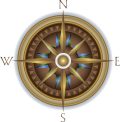By John M. Motter
“Bold and brash” best describes Archuleta County history, a saga of the Old West prescribed by rugged mountain remoteness and the distinctive characteristics of three proud cultures.
At least three national flags have symbolized ownership of Pagosa Country — claims not always recognized by the Indigenous Native Americans who hunted and fished here long before Columbus crossed the Atlantic.
Those flags belonged to Spain, Mexico and the United States, and an argument could be made that France also claimed the area for a period of time.
Evidence of prehistoric human occupation in the San Juan Mountains, including Archuleta County, is fairly abundant. Later, but before white men followed Indian trails into the area, the Ancestral Puebloans pursued a sedentary lifestyle near Chimney Rock and along the Piedra and San Juan rivers in the southwestern part of the county.
More recently, perhaps about the same time Hispanics arrived in New Mexico, Southern Ute, Jicarilla Apache and Navajo Indians found the fertile mountain valleys surrounding the Great Pagosa Hot Spring to their liking. They enjoyed, even worshipped, the medicinal benefits of the mineralized hot spring waters.
Hispanics wandered into Nuevo Mexico in the 16th century, hoping to fill their packs with gold. Even though they didn’t uncover fabulous golden riches, they stayed and, in order to survive, traded with the Native Americans. As a result, a trading party led by Juan Maria Rivera visited Pagosa Country in 1765. Not much later, in 1776, the priests Francisco Dominguez and Silvestre Escalante entered Archuleta County near present-day Carracas, intent on finding a path linking Spain’s New Mexico colonies with those in California. After reaching the central valley of Utah, the intrepid explorers turned back. Nevertheless, for years, Pagosa Country hills echoed to the clip-clop of mule trains trotting back and forth between California and New Mexico, along paths opened by these men.
By 1820, Pagosa Country acquired a new, if still foreign, ruling government. That is the year Mexico threw off the yoke of Spain and began administering her own affairs. Mexico’s greater tolerance for Anglos encouraged a steady stream of fur traders to set their traps in the San Juan watershed.
By 1846, trapping was largely a thing of the past and even bigger changes loomed on the horizon. The United States went to war with Mexico. Following the war, the United States owned about half of Mexico’s territory, including Pagosa Country.
Anxious to explore their new domain and to find a railroad route to California, the U.S. Army sent an expedition through Pagosa Country in 1859, headed by Capt. John Macomb. Macomb’s party included a number of scientists who mapped the route and rendered exquisite line drawings of the Great Pagosa Hot Spring and Chimney Rock. Macomb’s report is the first written description in English we have of Pagosa Country.
Soon after Macomb’s visit, in 1860, gold was discovered in the San Juan Mountains. For the next 30 years, a steady stream of prospectors and their supporters flowed through Pagosa Country. The growing number of settlers agitated the proud Southern Ute tribes, forcing the U.S. government to respond by sending troops into the area.
The San Juan River adjacent to the great Pagosa Hot Springs was chosen as a good point for locating troops. In 1878, Fort Lewis blossomed on one bank of the river, the town of Pagosa Springs on the other bank. Cattle ranchers chased their four-legged charges through the surrounding foothills.
Pagosa Country assumed all of the attributes of the Old West, with cavalry troops, cowboys and Native Americans, gunfights and barroom brawls, sheepmen and cattlemen, stagecoach holdups — all of the cherished traditions from which western movies are made.
Then, as suddenly as it had arrived, the Old West disappeared. Filling the void were railroads, lumber mills and loggers. Pagosa had its own narrow gauge railroad complete with a downtown depot. Nothing lasts forever and, after denuding much of the countryside, the railroad and logging industry moved out.
Colorado built a relatively modern highway over Wolf Creek Pass in 1916; trucks began to move most of the freight, and telephones, electricity and central water came to town. Local folks were caught between the new and the old. Cattlemen continued to raise beef for the market. Small lumber mills hacked away at the remaining trees. Then came the Great Depression and World War II. Many of the rural people eking out a scarcely adequate living moved to town, or further away to work in defense plants. The war ended, but few of those who had abandoned Pagosa Country returned. Pagosa had no payrolls.
Along about 1970, a number of land developers, ears tuned to the insistent jingle of change in affluent America’s pockets, began to subdivide and sell Pagosa Country land. Buyers responded enthusiastically, infatuated with the mountain panoramas, gurgling streams, seemingly endless ranks of mountain forests, and maybe with the idea that a little of the Old West lived on in Pagosa Country.
Since 1970, the population of Pagosa Country has increased dramatically. Shops have sprung up to meet the needs of new arrivals. Farsighted investors have developed the Great Pagosa Hot Springs and other natural attractions. But, even with change, Pagosa Country has remained unique — a beautiful, off-the-beaten-path refuge for resident and visitor alike.
The history of Pagosa Country, new and old, is etched in her people’s dynamic response to change. Even though the Old West is gone, the Old West background of soaring mountains, strident streams and abundant wildlife continue to dominate life here. As it has been from the beginning, Pagosa Country, dominated by God-given natural resources, remains bold and brash.
